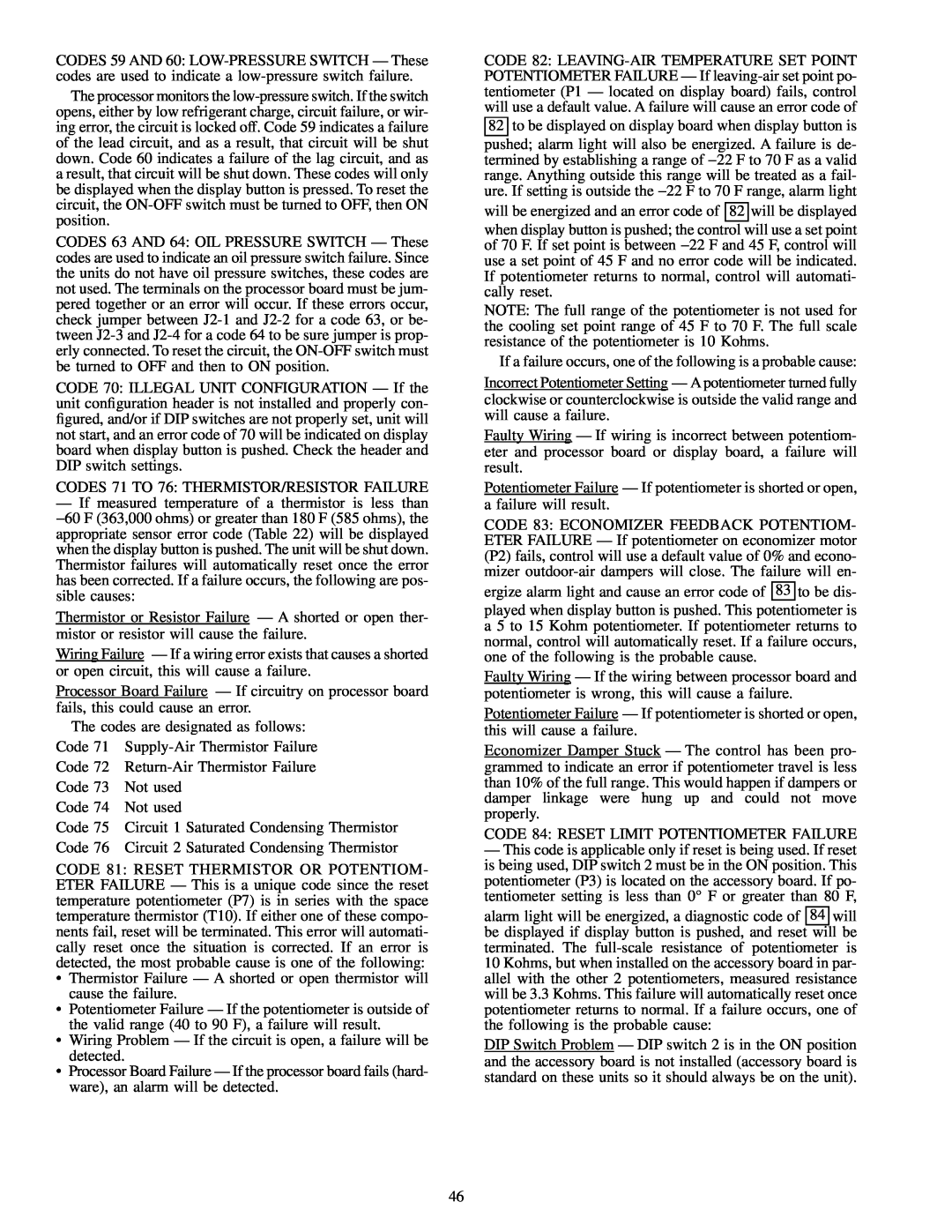
CODES 59 AND 60:
The processor monitors the
CODES 63 AND 64: OIL PRESSURE SWITCH Ð These codes are used to indicate an oil pressure switch failure. Since the units do not have oil pressure switches, these codes are not used. The terminals on the processor board must be jum- pered together or an error will occur. If these errors occur, check jumper between
CODE 70: ILLEGAL UNIT CONFIGURATION Ð If the unit con®guration header is not installed and properly con- ®gured, and/or if DIP switches are not properly set, unit will not start, and an error code of 70 will be indicated on display board when display button is pushed. Check the header and DIP switch settings.
CODES 71 TO 76: THERMISTOR/RESISTOR FAILURE
ÐIf measured temperature of a thermistor is less than −60 F (363,000 ohms) or greater than 180 F (585 ohms), the appropriate sensor error code (Table 22) will be displayed when the display button is pushed. The unit will be shut down. Thermistor failures will automatically reset once the error has been corrected. If a failure occurs, the following are pos- sible causes:
Thermistor or Resistor Failure Ð A shorted or open ther- mistor or resistor will cause the failure.
Wiring Failure Ð If a wiring error exists that causes a shorted or open circuit, this will cause a failure.
Processor Board Failure Ð If circuitry on processor board fails, this could cause an error.
The codes are designated as follows: Code 71
Code 74 Not used
Code 75 Circuit 1 Saturated Condensing Thermistor Code 76 Circuit 2 Saturated Condensing Thermistor
CODE 81: RESET THERMISTOR OR POTENTIOM- ETER FAILURE Ð This is a unique code since the reset temperature potentiometer (P7) is in series with the space temperature thermistor (T10). If either one of these compo- nents fail, reset will be terminated. This error will automati- cally reset once the situation is corrected. If an error is detected, the most probable cause is one of the following:
·Thermistor Failure Ð A shorted or open thermistor will cause the failure.
·Potentiometer Failure Ð If the potentiometer is outside of the valid range (40 to 90 F), a failure will result.
·Wiring Problem Ð If the circuit is open, a failure will be detected.
·Processor Board Failure Ð If the processor board fails (hard- ware), an alarm will be detected.
CODE 82:
82 to be displayed on display board when display button is
pushed; alarm light will also be energized. A failure is de- termined by establishing a range of −22 F to 70 F as a valid range. Anything outside this range will be treated as a fail- ure. If setting is outside the −22 F to 70 F range, alarm light
will be energized and an error code of 82 will be displayed
when display button is pushed; the control will use a set point of 70 F. If set point is between −22 F and 45 F, control will use a set point of 45 F and no error code will be indicated. If potentiometer returns to normal, control will automati- cally reset.
NOTE: The full range of the potentiometer is not used for the cooling set point range of 45 F to 70 F. The full scale resistance of the potentiometer is 10 Kohms.
If a failure occurs, one of the following is a probable cause:
Incorrect Potentiometer Setting Ð A potentiometer turned fully clockwise or counterclockwise is outside the valid range and will cause a failure.
Faulty Wiring Ð If wiring is incorrect between potentiom- eter and processor board or display board, a failure will result.
Potentiometer Failure Ð If potentiometer is shorted or open, a failure will result.
CODE 83: ECONOMIZER FEEDBACK POTENTIOM- ETER FAILURE Ð If potentiometer on economizer motor (P2) fails, control will use a default value of 0% and econo- mizer
ergize alarm light and cause an error code of 83 to be dis-
played when display button is pushed. This potentiometer is a 5 to 15 Kohm potentiometer. If potentiometer returns to normal, control will automatically reset. If a failure occurs, one of the following is the probable cause.
Faulty Wiring Ð If the wiring between processor board and potentiometer is wrong, this will cause a failure.
Potentiometer Failure Ð If potentiometer is shorted or open, this will cause a failure.
Economizer Damper Stuck Ð The control has been pro- grammed to indicate an error if potentiometer travel is less than 10% of the full range. This would happen if dampers or damper linkage were hung up and could not move properly.
CODE 84: RESET LIMIT POTENTIOMETER FAILURE
ÐThis code is applicable only if reset is being used. If reset is being used, DIP switch 2 must be in the ON position. This potentiometer (P3) is located on the accessory board. If po- tentiometer setting is less than 0° F or greater than 80 F,
alarm light will be energized, a diagnostic code of 84 will be displayed if display button is pushed, and reset will be terminated. The
DIP Switch Problem Ð DIP switch 2 is in the ON position and the accessory board is not installed (accessory board is standard on these units so it should always be on the unit).
46
